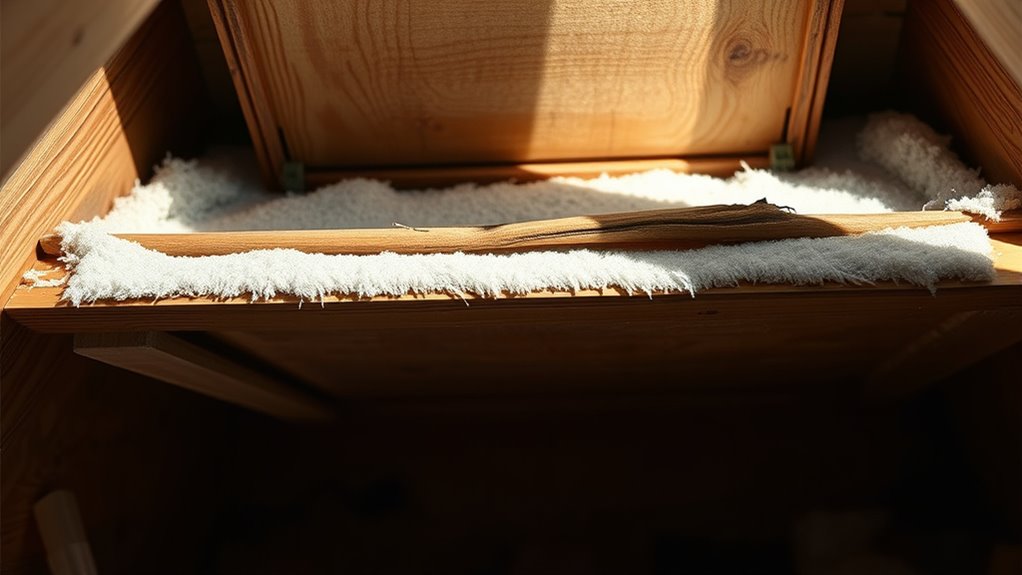Your attic hatch is often overlooked but can leak warm air and cause heat loss. Sealing gaps with weatherstripping or caulk helps prevent drafts, keeping your home cozy and saving on energy bills. Make sure the hatch insulation is adequate and doesn’t block ventilation or interfere with operation. Properly insulating and sealing this small area can make a big difference in comfort and efficiency. Keep exploring to discover more tips for better attic insulation.
Key Takeaways
- Properly insulating the attic hatch prevents heat loss and improves overall energy efficiency.
- Use suitable materials like foam board or rigid insulation to seal gaps effectively.
- Ensure the hatch operates smoothly without obstructing ventilation or airflow.
- Seal leaks around the hatch with weatherstripping or caulk to eliminate drafts.
- Regularly inspect and maintain insulation to keep the home cozy and prevent moisture issues.

Insulating your attic hatch is a simple yet effective way to prevent heat loss and improve your home’s energy efficiency. When you neglect this small but vital part of your insulation, warm air escapes through the gaps, making your heating system work harder and increasing your energy bills. Proper insulation of the hatch helps maintain a consistent indoor temperature and keeps your home cozy during cold months. To achieve ideal results, you need to consider not just insulation materials but also ventilation effectiveness and safety precautions. Good ventilation ensures that moisture doesn’t build up in your attic, which can lead to mold or wood rot. When sealing or insulating around the hatch, make sure you don’t block any existing vents or create a situation where air can’t circulate properly. This balance between sealing and ventilation is key to maintaining a healthy attic environment and preventing potential damage.
Before you start, safety precautions are essential. Always wear gloves, goggles, and a dust mask to protect yourself from insulation fibers, dust, and debris. Turn off the electrical power if you’re working near light fixtures or electrical outlets to avoid shocks. Make sure your ladder is stable and placed on a flat surface to prevent falls. If you’re working with spray foam or other chemical insulations, follow the manufacturer’s instructions carefully, and ensure the area is well-ventilated. It’s wise to double-check local building codes or consult professionals if you’re unsure about the best approach, especially when dealing with complex attic setups or existing ventilation systems. Additionally, understanding the importance of UST projectors and ALR screens can help you optimize your living space for comfort and efficiency.
When insulating the hatch, choose materials that provide good thermal resistance, like foam board or rigid insulation, which are easy to cut and install snugly around the hatch opening. Seal all gaps with weatherstripping or caulk to prevent drafts. If you’re installing insulation over or under the hatch, make sure it doesn’t interfere with the hatch’s operation or the attic’s ventilation pathways. Remember, the goal is to keep heat in without trapping moisture, so avoid sealing vents or any openings that serve a ventilation purpose. Regularly inspecting your attic hatch and insulation can help identify areas where drafts or moisture may be sneaking in. Properly insulating and sealing your attic hatch is a straightforward step toward greater energy efficiency, lowering heating costs, and maintaining a healthier home environment. Just keep safety in mind at every step, and you’ll ensure your insulation efforts are both effective and safe.
Frequently Asked Questions
How Often Should I Check My Attic Hatch for Leaks?
You should check your attic hatch for leaks at least twice a year as part of your insulation inspection routine. Regular attic hatch maintenance helps identify drafts, gaps, or damaged seals early, preventing energy loss. During these inspections, make sure the hatch is well-insulated and airtight. If you notice any issues, reseal or replace insulation promptly to maintain energy efficiency and keep your home comfortable year-round.
Can Weather Conditions Affect Attic Hatch Insulation?
Weather conditions can turn your attic hatch into a gateway for trouble, affecting insulation by exposing it to moisture and temperature swings. Cold, damp, or windy weather makes weatherproofing essential, as it helps prevent heat loss and moisture buildup. By maintaining proper moisture control and sealing gaps, you guarantee your insulation stays effective, keeping your home cozy regardless of the weather’s mood swings. Think of it as giving your home a warm, weather-resistant shield.
What Materials Are Best for Attic Hatch Insulation?
You should use foam board or rigid foam insulation for your attic hatch, as they provide excellent thermal resistance and are easy to cut to size. Make sure to also install proper attic hatch seals to prevent drafts. Combining quality insulation materials with airtight seals guarantees your hatch stays insulated, reducing heat loss and energy bills. These materials are durable, cost-effective, and improve your home’s overall energy efficiency.
Is Professional Installation Necessary for Insulating the Hatch?
You don’t need professional installation to insulate your attic hatch if you follow DIY tips. Using the right insulation types, like foam board or weatherstripping, makes the job easier and effective. Carefully measure, seal gaps, and add insulation snugly to prevent leaks. While professional help ensures perfect results, a well-informed DIY approach works fine if you’re comfortable with basic home improvement tasks.
How Much Energy Savings Can I Expect After Insulating?
You can expect significant savings—up to 10-15% on your energy bills—by insulating your attic hatch. When you enhance attic insulation, you improve energy efficiency by reducing heat loss during winter and keeping cool air in during summer. This simple step prevents drafts and leaks, making your home more comfortable and cost-effective. With proper insulation, you’ll notice fewer temperature swings and lower utility expenses, all while boosting your home’s energy efficiency.
Conclusion
Don’t let that leaky lid drain your warmth like a broken faucet. Insulating your attic hatch seals the deal, turning your home into a cozy fortress against the drafts and chills. Think of it as giving your house a warm hug, locking in comfort and saving you money. Once you’ve sealed that gap, you’ll feel the difference—like sunshine breaking through cloudy skies. Keep that lid tight, and enjoy the warmth that stays where it belongs.









